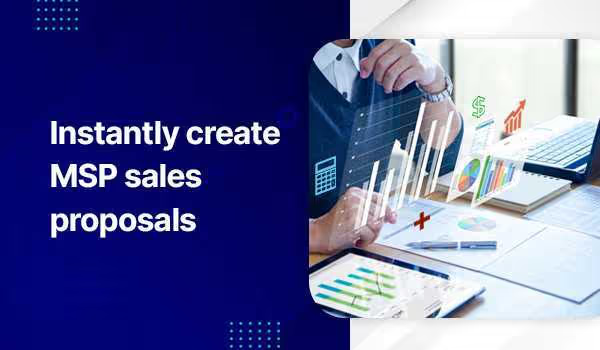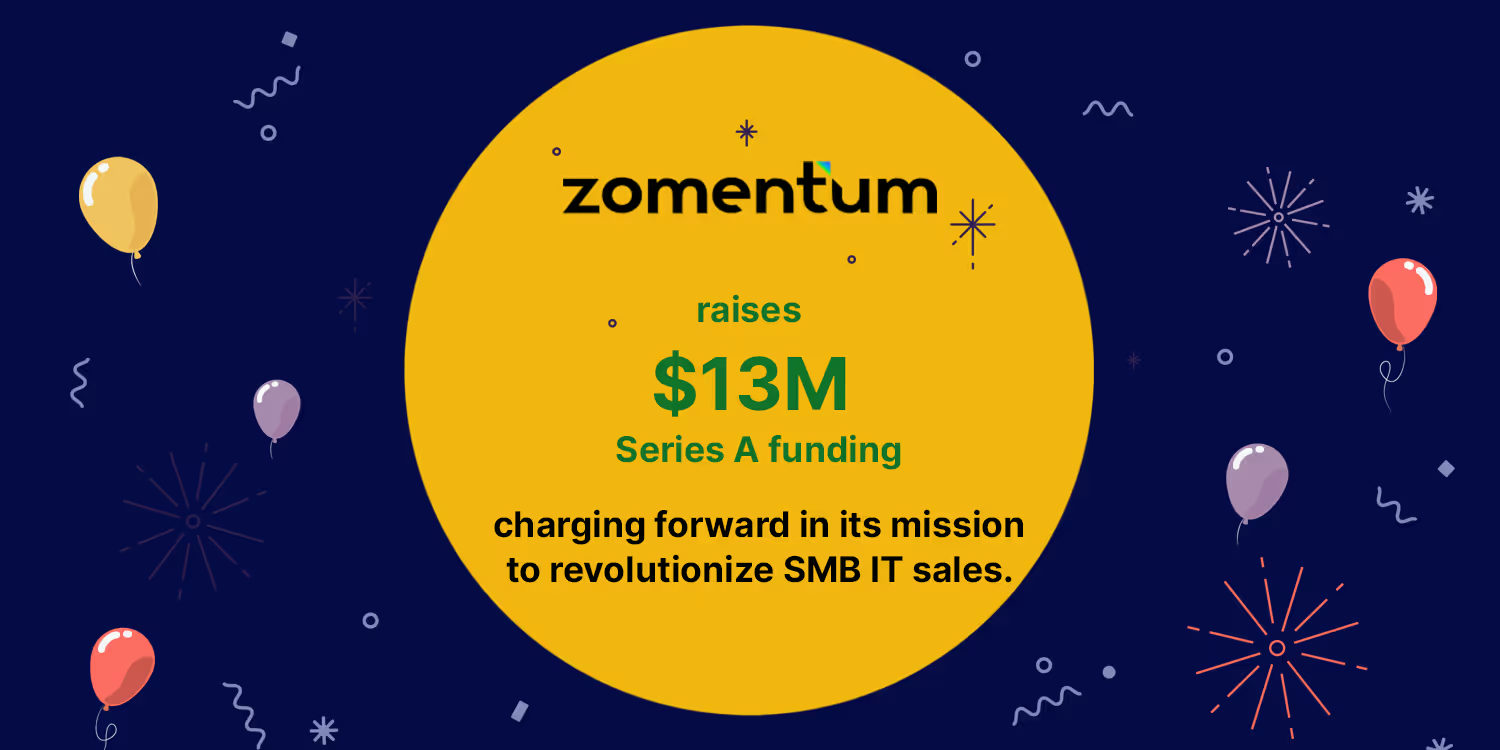The Ultimate Guide to Create MSP Sales Proposals

MSP sales proposals are more than just a document detailing what you can offer to a prospective client and how much it will cost them. It also has details on the hardware and software they’re going to sell or implement for a client, which comes with a set of its own nuances. A proposal has the power to make or break a deal; in the case of an MSP, it matters a lot more to the success of the sales process you have invested in.
As an MSP, your ability to create sales proposals can mean the difference between your company's short-term revenue and long-term success.
This guide aims to dive deep into everything you need to know about creating an MSP sales proposal that converts.
What is an MSP Sales Proposal?
Simply put, an MSP sales proposal is a document that outlines the products, services, and solutions that a managed service provider can offer to a prospective client or an existing customer. This includes the software and hardware that the MSP is going to sell to the client or implement for them, for which they are dependent on the technology companies that have built them. These are also commonly known as 'business proposals' or 'project proposals' in some industries and include a pricing breakdown of the scope of work.
Recommended read: Download free guide to creating successful MSP sales proposals with Zomentum
Why is an MSP Sales Proposal Important?
More often than not, sales proposals for MSPs are templatized. But let's take a look at why we think they need a little more attention before being sent:
1. Secures First Impressions
A sales proposal is often a prospective client's first impression of a well-crafted MSP's services when winning new business. It's like a first date - you want to impress, show off your greatest assets, and leave a lasting impression. A well-crafted proposal can help differentiate the MSP from competitors and demonstrate its value to clients. This can be the difference between winning and losing new business.
2. Sets Expectations
A sales proposal isn't just about winning new business - it's also about setting expectations. You could compare it to planning a trip with your friends. You want to ensure everyone is on the same page about the destination, the itinerary, and the costs involved. Similarly, a sales proposal sets expectations for the client and the MSP. It outlines the scope of work, timeline, and charges, ensuring that both parties are on the same page.
3. Establishes Authority and Builds Trust
A well-written sales proposal can build trust and establish the MSP as a credible and reliable partner beyond setting expectations. The proposal demonstrates that the MSP thoroughly understands the industry trends, benchmarks, and best practices, has taken note of the client's needs, and has a clear plan for meeting them.
Sales proposals will also help an MSP demonstrate that they have taken the time to understand the client's business and can deliver a tailored solution.
4. Creates a Roadmap
A sales proposal also serves as a roadmap for the project, outlining key milestones, deliverables, and timelines. This provides the client with a clear understanding of what to expect throughout the engagement. Moreover, it helps to ensure that the project stays on track.
5. Impacts Deal Closure
Lastly, coming to the most important point, the sales proposal is a tool for closing the deal. The proposal provides the client with the information they need to decide whether to engage in MSP's services. A well-crafted proposal can help overcome objections and persuade the client to choose the MSP over your competitors.
6. Documents Agreements With Hardware and Software Companies
A wellcrafted sales proposal also helps define the agreement you have with hardware and software solutions you intend to sell to the client, or implement for them. This may vary based on your scope of work and the extent to which you will be using the hardware or software.
Sales Proposal Statistics Your MSP Should Know
Before creating an MSP sales proposal, let's do a little number-crunching to understand why every step is important. Here are some MSP sales proposal statistics highlighted time and again through surveys by HubSpot and Salesforce:
- The average sales proposal win rate is 47%.
- Companies that use e-signatures close deals 21% faster than those that don't.
- Sales proposals with personalized videos see an 86% increase in click-through rates.
- The average number of proposal revisions is 2-3.
- Sales reps spend an average of 3.3 hours per proposal.
- The best day to send a sales proposal is Thursday.
- Sales proposals with pricing tables have a 54% higher conversion rate than those without.
- The most common reasons for losing a sale are price (68%), lack of differentiation (16%), and poor proposal quality (16%).
- Sales proposals with a video introduction are 38% more likely to close the deal.
- Including case studies or testimonials in sales proposals can increase the chances of a sale by 73%.
- 73% of buyers are more likely to purchase after reading a case study or testimonial, highlighting the importance of including social proof in your sales proposal.
- The optimal length for a sales proposal is between 6-10 pages, with five or fewer having a higher chance of being accepted but those over ten pages having a lower chance of being accepted.
Things to Know Before Creating an MSP Sales Proposal
Before you begin creating a sales proposal, you must clearly understand your MSP business and what you have to offer. Here are some key things to keep in mind:
- Whom you are selling to: Understanding your target market and their specific needs is critical to crafting a winning proposal. Consider the prospective client's industry, size, and pain points when developing your proposal.
- Unique selling proposition (USP): With so many MSPs in the market, it's essential to identify what sets your business apart. Consider your strengths, experience, and unique value proposition that can make your proposal stand out.
- Pricing model: Your pricing model should be clear and concise, outlining the services and features included in each package. It's also important to highlight any add-on services available to the prospect.
- Payment terms: Decide on payment terms, including whether you will be paid monthly, quarterly, or yearly. Including payment cycles and policies can help you get paid on time.
- Project duration: Consider whether you are looking for a short-term or long-term project. Be clear about the duration of the project and the potential for renewal.
- Hardware and software details: It should include details of the hardware and software you will be selling to the client or implementing for them during the project duration.
How to Write an MSP Sales Proposal?
When it comes to writing an MSP sales proposal, there are several steps that should be followed to ensure you cover all ground. Here are the key steps we have identified working with MSPs from across the globe:

- Gather information: Research is undeniably important. Before writing, gather all the necessary information about the client's needs and requirements, as well as their budget and timeline.
- Define the scope of work: Clearly define the scope of work and what services the MSP will provide to the client, and outline specific deliverables and milestones.
- Identify USPs: Highlight your MSP's unique selling points that differentiate you from competitors. This could be experience in a particular industry, technology, or a specialized team of experts.
- Address pain points: Address the client's pain points and how your MSP's services will solve their issues. Establish trust and demonstrate the value you bring to them.
- Develop a pricing model: Outline a pricing model tailored to the client's needs and budget. This could include different tiers of service or a subscription model.
- Provide a timeline: Provide a timeline for the project that outlines key milestones and deadlines. This helps to manage client expectations and ensure the project stays on track.
- Detail out the hardware and software: Based on what you’re offering to the client, you may need to sell or implement specific hardware and software to them during the project duration. Ensure you include details of the same, including their pricing and what it may cost them additionally.
- Use a professional template: Use a professional and well-designed template that includes the MSP's branding. This can make the proposal look more polished and establish credibility.
- Include a cover letter: Include a cover letter that addresses the client directly and summarizes the proposal's key points. Establish a personal connection with the client.
- Follow up: Follow up with the client after sending the proposal to answer any questions or concerns they may have. This can help establish trust further and demonstrate the MSP's commitment to its success.
- Personalize the proposal: Customize the proposal for each client and their specific needs. Demonstrate that you understand the client's unique challenges and can provide a tailored solution.
- Keep it concise: While providing detailed information is essential, keeping the proposal concise and easy to read is also important. Use bullet points and clear language to make the proposal more accessible.
- Review and edit: Before sending the proposal, review and edit it carefully to ensure no errors or inconsistencies. This helps establish the MSP's attention to detail and professionalism.
To streamline creating an MSP sales proposal, you can also use platforms like Zomentum.
Zomentum eases the process of creating sales proposals with the help of ready-to-use and customizable templates. These templates can be customized with project and pricing detail fields, branding, and more to help you navigate the above steps faster. They can be used multiple times, saving you time when it comes to creating proposals too.

PS. We will be sharing a detailed blog on what you should include in an MSP sales proposal. Remember to subscribe to our blog to be notified!
What Happens After You Send the MSP Sales Proposal?
Creating an MSP sales proposal is not the end of your job. Once you send it, we at Zomentum recommend that MSPs plan their follow-ups on a case-based scenario. We typically take the following three responses to sales proposals:
- First up, the good news scenario: your proposal is accepted! Congratulations! This is where Zomentum's workflow automation comes in handy. You can set up automated follow-up actions to ensure your onboarding process runs smoothly. From sending welcome emails to scheduling the kick-off call, Zomentum can help you stay on top of things and ensure your new client feels cared for from day one.
- Now, let's say the proposal gets rejected. It's not the end of the world - rejection happens to everyone! But, with Zomentum, you can turn this into a learning opportunity. You can automate a follow-up email asking for feedback on what went wrong and how you can improve your proposal next time. This shows your potential client that you care about their input and are committed to continuous improvement.
- Finally, the dreaded scenario - your proposal is ghosted. Don't panic - this happens more often than you might think. With Zomentum, you can set up automated follow-up emails to gently remind the client that you're still there and eager to move forward. This can help you get the conversation back on track and ensure you don't miss out on a potential sale.
Pro-tip: Remember also to keep time duration in mind. Don't spam or annoy your client with excessive emails.
Overall, Zomentum can help you streamline your sales proposal process and make it easier to handle different scenarios. By automating follow-up actions, you can save time and ensure your clients feel cared for at every funnel stage.
Conclusion
As your MSP business grows, the number of sales proposals you create will likely increase, and keeping track of them all is essential. While it may seem like a good idea to do so manually at the start, it's important to gradually move to leverage technology to streamline the process so that you don't miss out on any potential business opportunities.
This is where Zomentum comes in.
Zomentum is an all-in-one platform that can help you streamline your sales proposal process, keep track of your proposals, and automate follow-ups. You can create high-quality proposals quickly and efficiently with features like proposal templates and customizable workflows in minutes!
Struggling to gain control over your MSP sales proposals?
Suggested Blogs

What’s new in Zomentum - December 2019
.avif)
Zomentum Announces the Top Influential Partners of 2023: Leading the Way in Growth and Innovation

